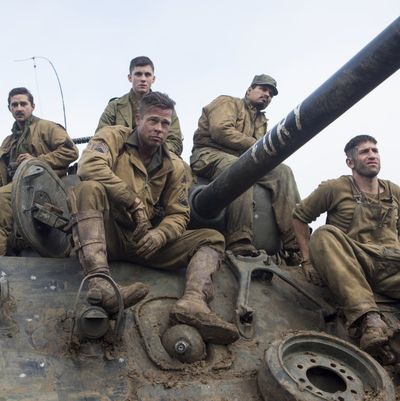
David Ayer’s Fury is a ferociously gory World War II film that raises all kinds of ugly moral questions before losing them in a cloud of blood and gore. It begins smashingly, though, with turns you rarely see in stories of “the Greatest Generation.” The scarred, leather-faced tank commander, Don “Wardaddy” Collier (an aggressively deglamorized Brad Pitt), butchers a solitary German officer rather than take him prisoner. A short time later, he not only decides to shoot an SS man who surrenders to him, but he forces — in an excruciatingly prolonged scene — a jittery clerk-typist, Private Norman Ellison (Logan Lerman), to pull the trigger. “Don’t make me do this!” weeps Ellison as Collier slaps him and wrestles him into position to fire a bullet into the head of a man who has pulled out photos of his wife and children and is begging for his life. And then — blam!
I’ve never been to war, but I’ve read enough personal reminiscences to know that what haunts many vets — sometimes as much as watching other soldiers die — is the murders they committed or witnessed. It’s important to hear about those actions, not necessarily because these men should be held to account. It’s because killing people — either prisoners or civilians — is the one thing they’re not allowed to talk about when they come back. There’s no outlet for it; it’s the great unmentionable. And on the evidence, it eats at them for the rest of their lives. Watching a heroic star like Pitt play an American World War II commander who kills (and does other unsavory things) without conscience, we’re forced to acknowledge the real meaning of “war is hell.” It’s not just what the bad guys do. It’s what the good guys do, too.
(Yes, I know Pitt killed Nazis with relish in Quentin Tarantino’s Inglourious Basterds, but that was WWII camp. Fury means to be ultrarealistic.)
Ayer has a grip on all his slippery issues. There’s a nightmarish absurdity about this final, horrendous burst of fighting. It’s spring of 1945, when Nazi defeat is all but certain, and yet Hitler has called for “total war.” Collier and his men roll into an Allied camp inside Germany with the corpse of their beloved gunner still in the tank, in pieces. Private Ellison, who’s supposed to take the dead man’s spot, has to clean up what’s left of him, which includes part of a face. “They murdered some good boys out there today,” Collier’s superior tells him. The tank commander listens, outward feeling burned away but clearly agonized inside. Rolling past German civilians hung by Nazis, he utters one of his many suitable-for-framing lines: “Ideals are peaceful. History is violent.” Collier accepts his own formulation with alacrity. He intends to kill every German he sees. On the end of his tank’s gun, the word “Fury” is scrawled.
The others in his crew consist of Shia LaBeouf as a religious soldier who sees God’s will in everything (“His number came up, that’s all”), Michael Peña as a smartass, and Jon Bernthal as the roughest-looking. They’re not such nice guys. They bully Lerman’s Ellison. They applaud whatever Collier does, even when it’s technically a war crime. But as they fight, you come to accept them, love them. It’s part of Fury’s creeping relativism.
Ayer serves up the ultimate test of our sympathies in the long, strange centerpiece, in which Collier and young Ellison make themselves at home in the flat of two German women (Anamaria Marinca and Alicia von Rittberg). The air is heavy with the threat of sexual violation; the women are virtual slaves to Collier’s whims. When Peña and Bernthal show up, the atmosphere becomes even more fraught — you wonder if these women will survive the encounter with Our Boys. The sappy, romantic note on which the scene ends is nearly unforgivable. The violation is that there’s no violation. Americans are sweeties at heart.
Fury doesn’t lose its hold on you, though. Some of the images are so hideous that they have the quality of myth, such as the corpse the tank rolls over that is so flattened, it has merged with the mud. Pitt — though he doesn’t disappear into his part, he’s obviously putting on his drawl — has an impressive stillness. He knows he’s playing both a man and a symbol, and he lets Ayer’s camera take his measure. Peña, Bernthal, and even LaBeouf (“even” because the actor’s sanity has lately been questioned) are fine, and while Lerman overdoes his character’s lip-licking naïveté, the writing isn’t exactly nuanced.
Ellison is the movie’s moral pivot and the character who suffers most when Ayer returns to formula with a vengeance. Fury comes down to whether the fresh-faced, horror-stricken clerk-typist can prove his manhood by rocking out behind a big gun as he sprays Germans with bullets. The revulsion that Steven Spielberg maintained to the end of Saving Private Ryan is nowhere in sight—Ayer betrays his own values with a climax that’s like a hack gamer’s recreation of Peckinpah’s The Wild Bunch. The final encounter between Ellison and a German soldier is meant to offer humanist balance, but in context it’s ludicrous. You can’t believe Ayer thought he could get away with it.
Though much of Fury crumbles in the mind, the power of its best moments lingers: the writhing of Ellison as he’s forced to kill; the frightening vibe of the scene with German women; the meanness on some soldiers’ faces and soul-sickness on others’. Our knowledge that German surrender is imminent gives the film an aura of tragic senselessness: This doesn’t need to happen. But Ayer knows that much of his audience consists of jocks eager to see Nazis royally wasted, and he gives them what they want. He represents the best and worst of American filmmaking: “Ideals are peaceful. Ditching them selectively wins the battle of the box office.”


